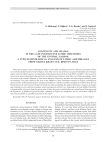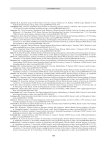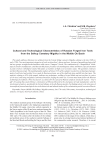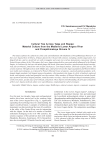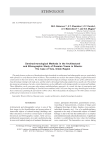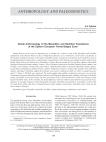Archaeology, Ethnology & Anthropology of Eurasia @journal-aeae-en
Статьи журнала - Archaeology, Ethnology & Anthropology of Eurasia
Все статьи: 524
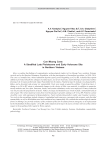
Con moong cave: a stratified late pleistocene and early holocene site in northern vietnam
Статья
Here, we outline the fi ndings of comprehensive archaeological studies in Con Moong Cave, northern Vietnam, carried out by the Russian-Vietnamese Expedition, with the participation of Australian specialists, in 2010–2014. The cave is a stratifi ed site, whose habitation deposits span a period beginning ca 42 ka BP. A detailed description of fi nds is provided. Diachronic changes in artifact types, use of raw materials, and technology are presented. Lithics from layers K–S represent the Early Upper Paleolithic Sơn Vi culture. Finds from layer K include core-shaped debris, fl akes, and a discoidal side-scraper (or sumatralith). Tools were made on quartzite pebbles. Finds from layer L, dating to ca 36 ka BP, attest to substantial changes in the choice of lithic raw material: in addition to quartzite, mostly andesite and, less often, limestone, basalt, and certain sedimentary rocks were employed. Primary reduction was not preceded by preparation of nuclei. Flakes are large and medium-sized. Tools include a sumatralith and an end-scraper. The richest material comes from Con Moong layers Q and S, dating to 26–21 ka BP. Preforms consist of pebble cores with unprepared striking platforms. Nuclei include fl at-parallel, radial, and irregular varieties. New tools in the assemblage include choppers, longitudinal and transverse convergent side-scrapers, and discoidal sumatraliths, as well as Hoabinhian axes and a unilateral axe (sumatralith). We conclude that archaeological remains from Con Moong Cave provide evidence of the evolution of the Sơn Vi culture from its emergence to its replacement by the Hoabinhian Technocomplex ~25 ka BP. Lithic industries from layers K and L correlate with one of the earliest stages in the peopling of this region by Homo sapiens.
Бесплатно
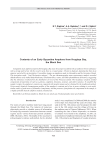
Contents of an Early Byzantine Amphora from Kruglaya Bay, the Black Sea
Статья научная
A fragment of an amphora found in the Kruglaya Bay near Sevastopol was filled with an unknown brown substance with a strong smell of tar. On the vessel’s neck, there is a round stamp ~30 mm in diameter, depicting the bust of an emperor encircled by an inscription. It resembles stamps on amphorae made in Alexandria and the Geronisos Island. The inscription reads, “επί Πτολεμαίου επάρχου”. The gas chromatography–mass spectrometry analysis revealed dehydroabietic acid, methyl dehydroabietate, norabietatrienes, retene, and other phenanthrene derivatives, suggesting that the substance resulted from dry distillation of wood of the Pinaceae family. The headspace analysis yielded components of turpentine oil such as α-pinene, camphene, limonene, cymenes, and others terpenes. To establish the sample’s origin, the amphora’s content was compared with modern pinewood tar obtained by the traditional method. Given nearly identical chromatogram profiles of the amphora’s contents and of tar in areas relating to resin acids, similar values of peak areas of biomarker components, and the presence of turpentine oil components in the sample, it is highly probable that the amphora indeed contained tar.
Бесплатно
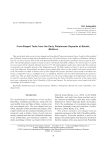
Core-shaped tools from the Early Pleistocene deposits at Bairaki, Moldova
Статья научная
This a rticle deals with a series of core-shaped tools from Early Pleistocene deposits (layers 5 and 6) of the stratifi ed site of Bairaki, located on high above-fl oodplain terrace VII of the Dniester, in the outskirts of Dubăsari, Moldova. The site was discovered in 2010 by the joint Russian-Moldovan archaeological expedition and excavated in 2011– 2014. The interdisciplinary studies revealed six layers with Early Paleolithic artifacts. Two lowest layers (5 and 6) are associated with the channel alluvium of terrace VII. The paleomagnetic studies have shown that these deposits correspond to the Jaramillo episode of the Matuyama epoch. The lithic industry of layers 5 and 6 are comparable to the Late Oldowan. Most artifacts are made of poor quality fl int; there are also pebble tools made of non-silicic rocks. Most lithics are small. A distinct series of core-shaped end-scrapers and side-scrapers made on residual cores (9 spec.), fragments (1 spec.), and fl akes (5 spec.) is identifi ed. All these tools are robust and had been processed in a similar way. They are made of pebbles no larger than 6 сm. The steep working edges of all implements in this series are heavily retouched. Similar items have been recorded from the Early Paleolithic materials of the region. Such tools were widespread in the Early Paleolithic of Africa and Eurasia. The earliest pieces were found in the Bed I assemblage of the Olduvai Gorge.
Бесплатно

Corvids in the Buryat Traditional Worldview
Статья научная
Using a structural-semiotic approach together with a comparative historical one, and based on ethnographic, lexical, and folklore sources, this study focuses on the raven and the crow as characters in Buryat mythology. Buryat terms for these birds are of Mongolian origin. Folk beliefs concerning the raven are more elaborate than those concerning the crow. The image of the raven is ambiguous, whereas the crow is an unambiguously negative character. The analysis of vocabulary and of the minor genres of folklore shows that Buryats paid attention to the various zoological features of these birds: plumage color and voice in the crow; plumage color, size, beak, flight duration, collectivism, emotionality in expressing joy and greed in the raven. The essence of both birds of prey was believed to be impure. The raven symbolized heaven, spring, vigilance, war, masculinity, and rancor. Being intelligent and independent, the raven was the Buddhist deity’s aide. Unlike the crow, the raven was patronized by evil spirits and other demonic characters. The crow was a feminine character, a symbol of sky, winter, water, bloodlust, and rumor. Both birds were associated with shape-shifting. The Buryat views, then, combined specifically ethnic and universal ideas about corvids.
Бесплатно
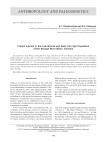
Cranial injuries in the late Bronze and early iron age population of the Shnogh river basin, Armenia
Статья обзорная
Бесплатно

Cranial traumas in a sample from the Pucar'a de Tilcara fortress (Jujuy province, Argentina)
Статья
We analyze injuries in the cranial sample from the Pucará de Tilcara fortress, dating to the time of the Inca conquest. Analysis of violence markers, carried out by visual examination and computed tomography, and the comparison of results with those relating to samples from the Regional Development Period of the Quebrada de Humahuaca valley, suggest that although the violence level remained high, its nature could have changed after the arrival of the Inca. The female sample reveals just two perimortal injuries, no trophy skulls were found, and the frequency of nasal bone fractures is higher than in earlier samples. This may indicate lower level of between-group fi ghting for control over resources, and higher risk of interpersonal violence. The observed pattern suggests that having arrived in the Quebrada de Humahuaca region, the Inca eased political tension by establishing control over trade routes and the distribution of arable land areas, which had previously been the main cause of local armed clashes. The infl uence of artifi cial cranial modifi cations on the pathological and traumatic status of individuals was also analyzed. Two types of modifi cation were recorded in the sample—fronto-occipital tabular oblique and fronto-occipital tabular straight. None of them caused pathological changes or a decrease in the thickness of cranial bones.
Бесплатно
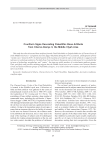
Cruciform signs decorating Paleolithic bone artifacts from Cherno-Ozerye II, the Middle Irtysh area
Статья
Бесплатно
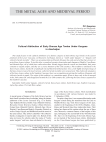
Cultural attribution of Early Bronze Age tombs under kurgans in Azerbaijan
Статья обзорная
Бесплатно
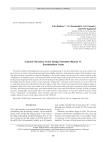
Cultural horizons at the Uyelgi cemetery mound 11, southeastern Urals
Статья научная
The article outlines the findings from excavations at Uyelgi mound 11, the most informative one at the cemetery. Its lower horizon revealed a burial demonstrating features highly indicative of the nomadic culture of the Southern Urals. The upper horizon contained two burials belonging to the Srostki culture, characterized by certain artifacts of the "Hungarian" (Carpathian) type, evidencing the return of some South Uralic groups from the west at the time when the Srostki people migrated in the opposite direction from Eastern Kazakhstan and the Altai. This conclusion is supported by findings from the Aktobe cemetery, where typically "Hungarian" ornaments of horse harness co-occur with a belt set with floral decoration following the Srostki tradition of the Altai. Inside the mound and on the platform under it, fragments of five clay vessels were found, most of which are decorated with comb-and-cord patterns of the post-Bakal, Nevolino, and Petrogrom-Yudina type, associated with the East Uralic and West Siberian Ugrians. In terms of spatial structure, stratigraphy, and typology, then, the Uyelgi mound 11 demonstrates at least four cultural horizons: South Uralic, "Hungarian" (Carpathian), Altaic (Srostki), and Ugric (East Uralic and West Siberian), jointly mirroring complex ethnic processes in the region between 800–1000 AD.
Бесплатно
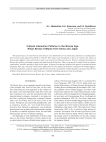
Cultural interaction patterns in the Bronze Age: ritual bronze artifacts from Korea and Japan
Статья
Бесплатно
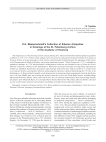
Статья научная
This study focuses on the drawings of items collected during D.G. Messerschmidt's fi rst multidisciplinary expedition to Siberia in 1719–1727. Pictures of the artifacts have been preserved among the documents held by the Academy of Sciences Archive in the personal papers of the traveler, which includes his fi eld journals, the appendices of his reports to the Pharmaceutical (Medical) Registry, and a large handwritten treatise “Sibiria Perlustrata” (1727), outlining the expedition's fi ndings. In 1728, Messerschmidt's archaeological collection was included as part of Peter the Great's Siberian Collection, exhibited at the Kunstkamera. Watercolor and pencil drawings and engravings depicting the exhibits are identifi ed. Handwritten descriptions and drawings of the items have made it possible to a certain extent to reconstruct the fi rst encyclopedist's Siberian archaeological collection, which perished during the 1747 fi re at the Kunstkamera. As Messerschmidt's graphic works demonstrate, he documented items spanning the time from the Bronze Age to the Late Middle Ages and covering the territory from the Urals to the Trans-Baikal region, including things imported from Western Europe, China, and Central Asia. Also, he collected archaeological items representing virtually all cultures of the Minusinsk Basin. It is concluded that in the fi rst third of the 18th century, Messerschmidt's collection was the world's largest and most representative assemblage of artifacts from northeastern Eurasia.
Бесплатно
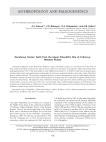
Deciduous human teeth from the Upper Paleolithic site of Yudinovo,Western Russia
Статья обзорная
Бесплатно
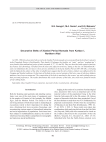
Decorative belts of Xianbei period nomads from Karban I, Northern Altai
Статья научная
In 1989–1990, five decorative belts worn by the Xianbei Period nomads were excavated from the Karban I cemetery in the Chemalsky District, Altai Republic. Their details (33 plaques, five buckles, six “units”, and two “pendant tips”) were found in four undisturbed graves of males (mounds 11, 27, 33, and 39). They are described with regard to function, decoration, and chronology. Parallels from the Altai and adjacent territories, dating to the late 1st millennium BC–early 1st millennium AD, are listed. A more precise attribution is the Early Xianbei Period (100–300 AD), correlating with the Bulan-Koby culture of the Altai. Available facts suggest that the style of these artifacts was influenced by the Xiongnu and Xianbei traditions. On the basis of the finds in situ, several variants of belt sets, some of which are hitherto unknown, have been reconstructed. The composition of the belts is unrelated to the owners' age and evidently mirrors their personal preferences. The results demonstrate the social relevance of the belts, since most were found in burials of top-ranking males.
Бесплатно

